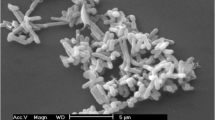Abstract
Mineralization of 2,4-dichlorophenoxyacetic acid (2,4-D) by two Alcaligenes eutrophus strains and one Pseudomonas cepacia strain containing the 2,4-D degrading plasmids pJP4 or pRO101 (=pJP4::Tn1721) was tested in 50 g (wet wt) samples of non-sterile soil. Mineralization was measured as 14C-CO2evolved during degradation of uniformly-ring-labelled 14C-2,4-D. When the strains were inoculated to a level of approximately 108 CFU/g soil, between 20 and 45% of the added 2,4-D (0.05 ppm, 10 ppm or 500 ppm) was mineralized within 72 h. Mineralization of 0.05 ppm and 10 ppm, 2,4-D by the two A. eutrophus strains was identical and rapid whereas mineralization by P. cepacia DBO1(pRO101) occurred more slowly. In contrast, mineralization of 500 ppm 2,4-D by the two A. eutrophus strains was very slow whereas mineralization by P. cepacia DBO1 was more rapid. Comparison of 2,4-D mineralization at different levels of inoculation with P. cepacia DBO1(pRO101) (6×104, 6×106 and 1×108 CFU/g soil) revealed that the maximum mineralization rate was reached earlier with the high inoculation levels than with the low level. The kinetics of mineralization were evaluated by nonlinear regression analysis using five different models. The linear or the logarithmic form of a three-half-order model were found to be the most appropriate models for describing 2,4-D mineralization in soil. In the cases in which the logarithmic form of the three-half-order model was the most appropriate model we found, in accordance with the assumptions of the model, a significant growth of the inoculated strains.
Similar content being viewed by others
Abbreviations
- 2,4-D:
-
2,4-dichlorophenoxyacetic acid
- CFU:
-
colony forming units
- PTYG:
-
peptone, tryptone, yeast & glucose
- DPM:
-
disintegrations per minute
References
Alexander M (1981) Biodegradation of chemicals of environmental concern. Science 211: 132–138
Brunner W & Focht DD (1984) Deterministic three-half-order kinetic model for microbial degradation of added carbon substrates in soil. Appl. Environ. Microbiol. 47: 167–172
Chaudhry GR & Chapalamadugu S (1991) Biodegradation of halogenated organic compounds. Microbiol. Rev. 55: 59–79
Crawford RL & Mohn WW (1985) Microbiological removal of pentachlorophenol from soil using a Flavobacterium. Enzyme Microb. Technol. 7: 617–620
Don RH &Pemberton JM (1981) Properties of six pesticide degradation plasmids isolated from Alcaligenes paradoxus and Alcaligenes eutrophus. J. Bacteriol. 145: 681–686
Focht DD & Brunner W (1985) Kinetics of biphenyl and polychlorinated biphenyl metabolism in soil. Appl. Environ. Microbiol. 50: 1058–1063
Ghosal D, You I-S, Chatterjee DK & Chakrabarty AM (1985) Microbial degradation of halogenated compounds. Science 228: 135–142
Goldstein RM, Mallory LM & Alexander M (1985) Reasons for possible failure of inoculation to enhance biodegradation. Appl. Environ. Microbiol. 50: 977–983
Greer CW, Hawari J & Samson R (1990) Influence of environmental factors on 2,4-dichlorophenoxyacetic acid degradation by Pseudomonas cepacia isolated from peat. Arch. Microbiol. 154: 317–322
Harker AR, Olsen RH & Seidler RJ (1989) Phenoxyacetic acid degradation by the 2,4-dichlorophenoxyacetic acid (TFD) pathway of plasmid pJP4: Mapping and characterization of the TFD regulatory gene, tfdR. J. Bacteriol. 171: 314–320
Jacobsen CS & Pedersen JC (1992) Growth and survival of Pseudomonas cepacia DBO1(pRO101) in soil amended with 2,4-dichlorophenoxyacetic acid. Biodegradation. 2: 245–252
Kilbane JJ, Chatterjee DK & Chakrabarty AM (1983) Detoxification of 2,4,5-trichlorophenoxyacetic acid from contaminated soil by Pseudomonas cepacia. Appl. Environ. Microbiol. 45: 1697–1700
Kukor JJ, Olsen RH & Siak J-S (1989) Recruitment of a chromosomally encoded maleylacetate reductase for degradation of 2,4-dichlorophenoxyacetic acid by plasmid pJP4. J. Bacteriol. 171: 3385–3390
Kunc F, Rybářová J & Lasík J (1984) Mineralization of 2,4-dichlorophenoxyacetic acid in soil simultaneously enriched with saccharides. Folia Microbiol. 29: 148–155
Maniatis T, Fritsch EF & Sambrook J (1982) Molecular cloning, a laboratory manual. Cold Spring Harbor Laboratory. Cold Spring Harbor, New York
Ou L-T (1984) 2,4-D degradation and 2,4-D degrading microorganisms in soils. Soil Sci. 137: 100–107
Ou L-T, Rothwell DF, Wheeler WB & Davidson JM (1978) The effect of high 2,4-D concentrations on degradation and carbon dioxide evolution in soils. J. Environ. Qual. 7: 241–246
Parker LW & Doxtader KG (1982) Kinetics of microbial decomposition of 2,4-D in soil: Effects of herbicide concentration. J. Environ. Qual. 11: 679–684
Ramadan MA, El-Tayeb OM & Alexander M (1990) Inoculum size as a factor limiting success of inoculation for biodegradation. Appl. Environ. Microbiol. 56: 1392–1396
Robinson JA (1985) Determining microbial kinetic parameters using nonlinear regression analysis. Adv. Microb. Ecol. 8: 61–114
Scow KM, Simkins S & Alexander M (1986) Kinetics of mineralization of organic compounds at low concentrations in soil. Appl. Environ. Microbiol. 51: 1028–1035
Short KA, Seidler RJ & Olsen RH (1990) Survival and degradative capacity of Pseudomonas putida induced or constitutively expressing plasmid-mediated degradation of 2,4-dichlorophenoxyacetate (TFD) in soil. Can. J. Microbiol. 36: 821–826
Simkins S & Alexander M (1984) Models for mineralization kinetics with the variables of substrate concentration and population density. Appl. Environ. Microbiol. 47: 1299–1306
Simkins S & Alexander M (1985) Nonlinear estimation of the parameters of Monod kinetics that best describe mineralization of several substrate concentrations by dissimilar bacterial densities. Appl. Environ. Microbiol. 50: 816–824
Simkins S, Mukherjee R & Alexander M (1986) Two approaches to modeling kinetics of biodegradation by growing cells and application of a two-compartment model for mineralization kinetics in sewage. Appl. Environ. Microbiol. 51: 1153–1160
Smith AE, Aubin AJ & Biederbeck VO (1989) Effects of long-term 2,4-D and MCPA field applications on soil residues and their rates of breakdown. J. Environ. Qual. 18: 299–302
Tiedje JM, Colwell RK, Grossman YL, Hodson RE, Lenski RE, Mack RN & Regal PJ (1989) The planned introduction of genetically engineered organisms: Ecological considerations and recommendations. Ecology 70: 298–315
Author information
Authors and Affiliations
Rights and permissions
About this article
Cite this article
Jacobsen, C.S., Pedersen, J.C. Mineralization of 2,4-dichlorophenoxyacetic acid (2,4-D) in soil inoculated with Pseudomonas cepacia DBO1(pRO101), Alcaligenes eutrophus AEO106(pRO101) and Alcaligenes eutrophus JMP134(pJP4): effects of inoculation level and substrate concentration. Biodegradation 2, 253–263 (1991). https://doi.org/10.1007/BF00114557
Received:
Accepted:
Issue Date:
DOI: https://doi.org/10.1007/BF00114557




